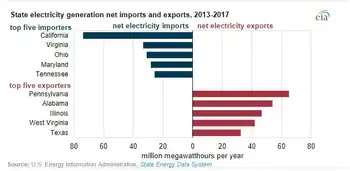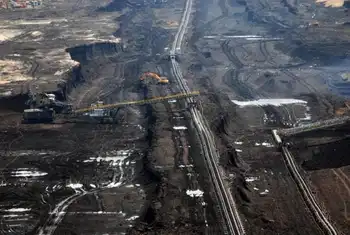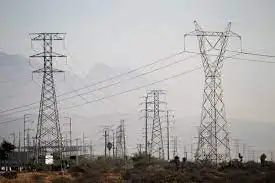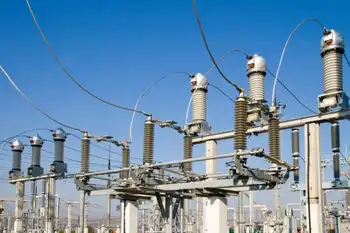Dubie pushes for Vermont power line path
The line, sometimes referred to as a "hockey stick" shape around Vermont, would move power from the massive network of dams in Canada to Southern New England states without going through Vermont. That would also mean it would be built without construction jobs in the state and without Vermont utilities or regulators having any say over it.
That could be bad for Vermont, according to Lt. Gov. Brian Dubie.
In addition to buying electricity from HQ — which for now provides roughly a third of the state's power needs — Vermont also is home to two of the major power lines bringing electricity from Canada to the United States. The Highgate converter connects the HQ system to Vermont's power grid, matching the electricity in the Canadian system to the U.S. power grid. The second power line, a direct current path through Vermont's Northeast Kingdom, takes electricity into the rest of New England.
Dubie, who is running to replace Gov. James Douglas when he retires in January 2011, said recently that he knows most politicians run from any support of a proposed power line.
But Dubie said he believes the solution is more important than politics because it offers Vermont options. It makes sense to advocate for the line to be built through Vermont, rather than around it, Dubie said.
For one thing, the territory in New Hampshire in which the line might be built largely is untouched, or "virgin," forest land. Instead, the line could follow the existing DC line through the Northeast Kingdom (although the right-of-way might have to be expanded) if it were built in Vermont, Dubie said.
"Anyone concerned with the environment is not going to accept cutting trees when there is an existing corridor," he said.
The project — the United States' portion of which is expected to cost roughly $900 million — would bring a significant number of jobs to Vermont at least while it is being built, Dubie added.
Such power lines also provide tax dollars and bring other sources of money to communities through which they run, he pointed out.
Plus, the power line would offer choices when the state seeks news supplies of power. Both the current contracts with the Vermont Yankee nuclear plant and the current contracts with the HQ are slated to begin expiring in a few years, rolling well into the next decade.
"If we go after this option, it will allow us choices as we go forward," Dubie said.
Finally, there is the chance to preserve the relationship between the state and Hydro-Quebec, Dubie said. "Right now we have something special with HQ," he said. "We are going to be losing our strategic location."
This power push largely has been a solo mission for Dubie.
In fact, Vermont regulators have not objected to the construction of the proposed line through New Hampshire and neither have the state's utilities — at least not publicly.
Meanwhile, while engineering and the exact path the proposed line would follow through New Hampshire have yet to be finalized, building in Vermont currently is not being considered.
"Going through one state instead of two (states) seems to make more sense," said Martin Murray of Public Service New Hampshire, a subsidiary of Northeast Utilities System, one of the companies considering building the line. "If you introduce two state governments, and crossing one state line into another, you are complicating the project."
As for the DC line through Vermont "the existing line is completely filled to capacity at this point," Murray said. "One could not use the line that is there, nor could one use the existing right-of-way without significantly expanding it."
A Hydro-Quebec spokesman merely said the location of the line still is being worked out.
In any case, other factors — mostly the increased supply and lower cost of natural gas on which the cost of New England's electricity is largely based — may be slowing construction of the line.
Ironically, Dubie may find some assistance among the state's environmentalists.
"If this proves to be a good project, which is a hurdle it has not jumped over yet, it should definitely go through an existing corridor — not through virgin forest," said James Moore of the Vermont Public Interest Research Group.
But the power line proposed by Northeast Utilities and Nstar, a Massachusetts utility, is only one part of the impending changes in the power transmission system in New England and New York. How much of a say Vermont has in those discussions remains to be seen, Moore said.
"We either need to make it happen, or it is going to happen to us," he warned.
Because of the structure of the electricity grid, new power sources in upstate New York — especially wind power projects — have resulted in electricity that may have a hard time reaching a market of users. One possibility will be an expansion of the power line (actually two lines) that now runs between New York State and Vermont via Lake Champlain, and may need to be worked on to maintain its reliability.
The discussion of New England transmission lines is set against a backdrop of the possibility of a massive power transmission project to move electricity from renewable sources in the west to customers in the Midwest and perhaps to the east coast, said John Donleavy of the Vermont Electric Power Co., or VELCO, which is responsible for ensuring power can get to customers in Vermont.
Governors from around New England have urged the development of renewable energy in the region, including wind power inland and off the coastline — a possible alternative to the large interstate power project. That alternative also could include a power line built from Maine, across the top of New England, and perhaps into Vermont, as well as other transmission lines that could affect Vermont.
"There is plenty or wind energyÂ… right here in New England," Donleavy said. "We think it is more cost-effective; we think it is a better regional solution."
Vermont, because of its location and history, likely will be a part of those large-scale transmission plans. "Above us, we have Hydro-Quebec resources, wind and water. Over across the lake, there is a tremendous amount of resources that are stranded," Donleavy said.
One of VELCO's jobs is to provide the state and its distribution utilities with a variety of options from which to choose — including perhaps having a portion of the Northeast Utilities line built in Vermont.
"The shortest point between the two places could cut across the corner of Vermont and the plan proposed at this time goes around Vermont," he said.
"From an economic development standpoint, building transmission projects for reliability has had a very positive effect on the state," he added.
There is one thing that might make building the power line through Vermont more expensive than it would otherwise be, however, said Richard Mallary, a former U.S. representative from Vermont and former VELCO president.
That's the fact that Vermont has resisted allowing the tall steel towers used elsewhere for power transmission lines. "Vermont has insisted on relatively low-profile construction," Mallary said. Still, given the existing right-of-way, and without major regulatory problems, building the proposed line through Vermont might make sense, he said.
"If the regulatory problems were not severe, I expect using an existing corridor would be cheaper than going through 70 miles of New Hampshire wilderness," Mallary said.
He said he's not sure how much of a boost in access to HQ power Vermont would get by hosting a portion of the line. "I don't see how we would have a lot of leverage with either the rest of New England or with HQ as long as there are other options," he said.
HQ may become increasingly important as more renewable power sources come online in New England for another reason, as well. Mallary said Hydro-Electric dams and the lakes behind them can be an important way of storing power, since the water-powered electricity can be released at will when intermittent sources such as wind or solar electricity are not running.
"It is one of the cheapest ways of storing energy," he said. "Hydro-Quebec is a wonderful battery."
In the meantime, as those larger plans are worked out, Dubie said he will keep pushing for a part of the proposed line into Vermont.
"As lieutenant governor, I have a problem with it," he said of the line which may be built around Vermont. "I am willing to take the risk and say 'let's build transmission' because it provides us with options."
Related News

EIA: Pennsylvania exports the most electricity, California imports the most from other states
WASHINGTON - According to the U.S. Energy Information Administration (EIA) State Electricity Profiles, from 2013 to 2017, Pennsylvania was the largest net exporter of electricity, while California was the largest net importer.
Pennsylvania exported an annual average of 59 million megawatt-hours (MWh), while California imported an average of 77 million MWh annually.
Based on the share of total consumption in each state, the District of Columbia, Maryland, Massachusetts, Idaho and Delaware were the five largest power-importing states between 2013 and 2017. Wyoming, West Virginia, North Dakota, Montana and New Hampshire were the five largest power-exporting states. Wyoming and West Virginia…




